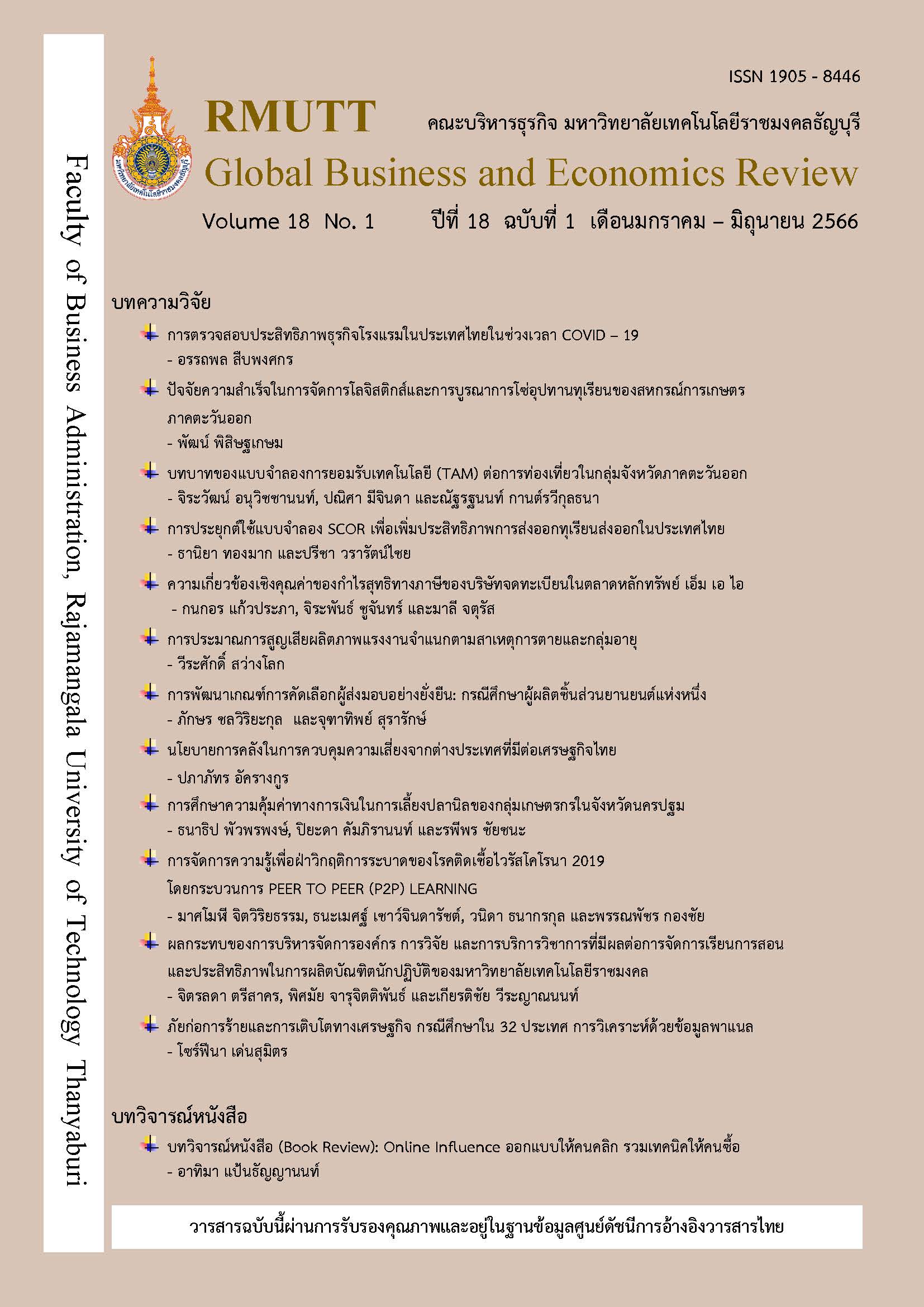FISCAL POLICY IN CONTROLLING FOREIGN RISKS TO THE THAI ECONOMY
Keywords:
Fiscal Policy, Russia-Ukraine War, US Interest RateAbstract
The objective of this research is to study the effectiveness of fiscal policy in addressing Thailand's economic problems due to foreign risks. The quantitative analysis relies on quarterly secondary economic data for the period 2011–2020, using the three- stage least squares method and projections simultaneously across the entire system. The findings of this study simulate the situation during 2021–2024 when Thailand faced the problems of the Russia–Ukraine war along with the US interest rate hike. It was found that fiscal policy alone could not solve two problems that occurred simultaneously: the economic downturn and the payment deficit; i.e., the expenditure budget increase could stimulate the economy but could not solve the payment deficit. Measures to increase foreign investment can improve the balance of payments but do not solve the economic downturn. However, the researcher suggested that monetary policy should be used together to solve both problems. Because the strength of monetary policy, especially the weak baht measure, can help the economy recover along with the balance of payments, it is necessary to use a mixed policy to solve this problem. In addition, this study also found that the rise in US interest rates harmed Thailand. It is higher than the impact of the Russia-Ukraine war.
References
ฉัตรสุดา ถิ่นพังงา. (2566). การศึกษาความสัมพันธ์ระหว่างนโยบายการคลังและการเจริญเติบโตทางเศรษฐกิจกับความเหลื่อมล้ำทางรายได้ของประเทศไทย. (วิทยานิพนธ์ปริญญามหาบัณฑิต, มหาวิทยาลัยธรรมศาสตร์). สืบค้นจาก https://doi.org/10.14457/tu.the.2018.545
ญาดา รอดสำราญ. (2556). แรงกระตุ้นทางการคลังของ 4 ประเทศในภูมิภาคเอเชียตะวันออกเฉียงใต้. วารสารมนุษยศาสตร์และสังคมศาสตร์, 1(1), 52-61.
ดอน นาครทรรพ. (2565). ฤา เศรษฐกิจไทยจะไม่พ้นวิบากกรรม: เศรษฐกิจสหรัฐเสี่ยงถดถอย?. สืบค้นจาก https://www.bot.or.th/Thai/ResearchAndPublications/articles/Pages/Article_5May2022.aspx
ถวิล นิลใบ. (2553). ประสิทธิภาพของนโยบายการคลังของประเทศไทย. สืบค้นจากhttps://doi.nrct.go.th//ListDoi/listDetail?Resolve_DOI=10.14457/RU.res.2010.36
ธนาคารแห่งประเทศไทย. (2565). รายงานนโยบายการเงิน. สืบค้นจาก https://www.bot.or.th/Thai/MonetaryPolicy/MonetPolicyComittee/MPR/BOX_MPR/BOX2Q1_RusiaUkrain.pdf
บัณฑิต ชัยวิชญชาติ. (2546). การเปลี่ยนแปลงโครงสร้างระบบเศรษฐกิจไทยในแบบจำลองเศรษฐกิจมหภาคเชิงพลวัต. (วิทยานิพนธ์ปริญญามหาบัณฑิต, จุฬาลงกรณ์มหาวิทยาลัย). สืบค้นจาก http://www.library.rmutt.ac.th/wp-login.php?url=https://search.ebscohost.com/login.aspx?direct=true&db=edsbas&AN=edsbas.B5A9A2D8&site=eds-live&authtype=ip,cookie,uid
ภูริวัฒ ยุทธวรวิทย์. (2566). นโยบายการคลังกับการเจริญเติบโตทางเศรษฐกิจและการสะสมทุนมนุษย์ในประเทศไทย. สืบค้นจาก https://doi.org/10.14457/tu.the.2020.821
สมบูรณ์ ศิริสรรหิรัญ, นิศาชล ฉัตรทอง, ติณณภพ พัฒนะ, ณิชกานต์ บรรพต, และ คณิศร เทียนทอง. (2562). การคลังภาครัฐเปรียบเทียบ: กรณีศึกษาไทย สหรัฐอเมริกา สหราชอาณาจักร สาธารณรัฐสิงคโปร์ และสาธารณรัฐเกาหลี. วารสารสังคมศาสตร์บูรณาการ, 6(1), 257-299.
สุบรรณ เอี่ยมวิจารณ. (2559). การกำหนดนโยบายการคลังภายใต้การประยุกต์ใช้ปรัชญาของเศรษฐกิจพอเพียง. วารสารสถาบันวิจัยและพัฒนา มหาวิทยาลัยราชภัฏมหาสารคาม, 3(2), 73-86.
อรรณพ ศิริชัย. (2553). ผลของการดำเนินนโยบายการคลังที่มีต่อเป้าหมายทางเศรษฐกิจของไทย. (วิทยานิพนธ์ปริญญามหาบัณฑิต, มหาวิทยาลัยเกษตรศาสตร์). สืบค้นจากhttps://doi.org/10.14457/ku.the.2010.769
Alcidi, C., D'Imperio, P., & Thirion, G. (2023). Risk-sharing and consumption-smoothing patterns in the US and the Euro area: A comprehensive comparison. Structural Change and Economic Dynamics, 64, 58-69. Retrieved from https://doi.org/10.1016/j.strueco.2022.11.005
Christensen, J. H. E., & Spiegel, M. M. (2023). Central bank credibility during COVID-19: Evidence from Japan [Article]. Journal of International Money and Finance, 131, Retrieved from https://doi.org/10.1016/j.jimonfin.2022.102788
Ebeke, C. H., & Eklou, K. M. (2023). Automation and the employment elasticity of fiscal policy. Journal of Macroeconomics, 75, Retrieved from https://doi.org/https://doi.org/10.1016/j.jmacro.2023.103502
Kocherlakota, N. R. (2022). Stabilization with fiscal policy. Journal of Monetary Economics, 131, 1-14. Retrieved from https://doi.org/https://doi.org/10.1016/j.jmoneco.2022.07.007
Shah, S. A., & Garg, B. (2023). Testing policy effectiveness during COVID-19: An NK-DSGE analysis. Journal of Asian Economics, 84. Retrieved from https://doi.org/https://doi.org/10.1016/j.asieco.2022.101577
Sosvilla-Rivero, S., & Rubio-Guerrero, J. J. (2022). The economic effects of fiscal policy: Further evidence for Spain. The Quarterly Review of Economics and Finance, 86, 305-313. Retrieved from https://doi.org/https://doi.org/10.1016/j.qref.2022.08.002
Wang, Y., Wang, X., Zhang, Z., Cui, Z., & Zhang, Y. (2023). Role of fiscal and monetary policies for economic recovery in China. Economic Analysis and Policy, 77, 51-63. Retrieved from https://doi.org/https://doi.org/10.1016/j.eap.2022.10.011
Weyerstrass, K., & Kovac, R. (2023). Fiscal policies in the Federation of Bosnia and Herzegovina: are spending or revenue measures more effective?. Empirica, 50(1), 173-206. Retrieved from https://doi.org/10.1007/s10663-022-09562-9
Wu, H., Xu, Z., & Yan, P. (2022). Financial repression, SOE reform and fiscal-monetary policy coordination. China Economic Quarterly International, 2(2), 151-163. Retrieved from https://doi.org/https://doi.org/10.1016/j.ceqi.2022.06.001
Downloads
Published
How to Cite
Issue
Section
License
Copyright (c) 2023 ปภาภัทร อัครางกูร

This work is licensed under a Creative Commons Attribution-NonCommercial-NoDerivatives 4.0 International License.
The articles published in this journal are the intellectual property of their respective authors.
The views and opinions expressed in each article are solely those of the individual authors and do not reflect the positions of Rajamangala University of Technology Thanyaburi or any of its faculty members. All components and content of each article are the sole responsibility of the respective authors. In the event of any errors, the authors shall bear full responsibility for their own work.








